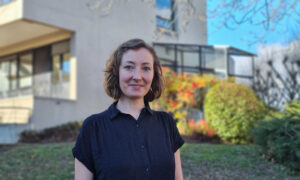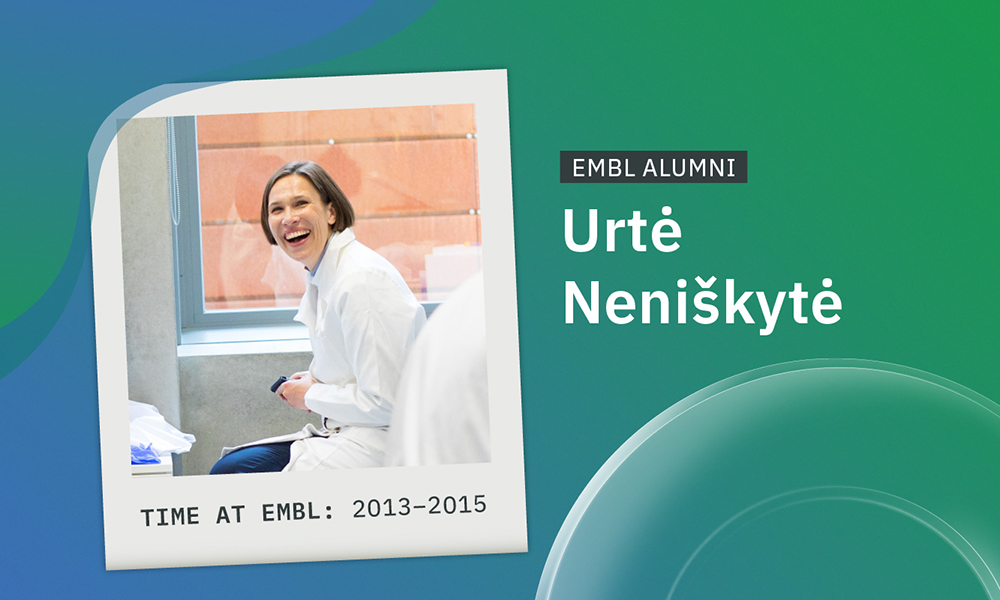
Read the latest Issue
An EMBL alumna returned to her native Lithuania, becoming one of the founding group leaders in the Vilnius University-EMBL Partnership Institute, helping to advance genome-editing technologies there.

Name: Urtė Neniškytė
Time at EMBL: 2013–2015; postdoc in Gross group at EMBL Rome
Current job title: Group Leader at Vilnius University-EMBL Partnership Institute for Genome Editing Technologies
Whereabouts since EMBL: After EMBL, I received an MSCA fellowship at Vilnius University in the Department of Neurobiology and Biophysics of Life Sciences Center. In 2018, returning from maternity leave, I started my own group to study molecular mechanisms of neuronal circuitry refinement in developing brains. After Vilnius University and EMBL’s partnership for genome-editing technologies, I was selected as one of six new group leaders to start the VU-EMBL Partnership Institute. It has been a challenging two years, but I really enjoy the collaborative environment we’ve built.
“When I reminisce about my time there [at EMBL Rome], my memories are filled with Italian heat, the taste of figs straight from that tree, and collegial chat under the parasols in the yard.”— Urtė Neniškytė, Former EMBL Rome Postdoc
Impact of VU-EMBL Partnership Institute: The group leaders come from all over the world, and it is great to merge different experiences to build this world-class research institution. Historically, Lithuania has not been seen as a research destination, despite very strong research groups in biochemistry and molecular biology (e.g., EMBO members Virginijus Šikšnys and Saulius Klimašauskas). This institute will definitely have a positive impact, placing Vilnius University on the map of places to do a PhD or postdoctoral fellowship.
Best way to describe your previous and current work: While pursuing a PhD at the University of Cambridge, I started investigating the interaction of neurons and brain immune cells – microglia – in Alzheimer’s disease. With an amazing team, I contributed to the first papers that demonstrated that microglial phagocytosis, a process which clears cell debris and dead cells in the brain, also actively contributes to neuronal loss in neuroinflammatory conditions. Because the same molecular pathways have been shown to be activated in both neurodegeneration and in neurodevelopment, I became interested in investigating microglial phagocytosis in developing brains.
With Cornelius Gross at EMBL Rome, I explored molecular signals that define which neuronal connections have to be pruned during development. It took a while, but we just published a paper related to this work. At Vilnius University, we continue to investigate the molecular bases of neuronal circuitry refinement. I am particularly excited about our projects on local synaptic transcriptome during plasticity windows (done in collaboration with EMBL GeneCore) and the role of glycocalyx (a sugar coating on our cells) in developing and diseased brains. For the latter, we are collaborating with Vilnius University Hospital neurosurgeons to obtain surgically resected human brain tissue for secondary use in molecular studies. Importantly, since becoming a part of VU-EMBL Partnership Institute, we are also introducing gene editing techniques and developing new vectors to deliver gene editing tools into mammalian brains and investigate their application for certain diseases with neurological components.
Expectations for gene editing applications: The discovery of the CRISPR-Cas9 genome editing tool provided new opportunities to treat neuropathologies, especially those caused by single-gene mutations, such as cystic fibrosis and sickle cell anaemia. However, for a long time, advancing gene editing therapies for human disorders has lagged behind the developing relevant molecular tools – for a couple of reasons. First of all, animal models often do not adequately reflect the disease they are modelling but rather downstream effects of dysregulated genes. That means they cannot be used to develop gene editing approaches to treat these diseases. Importantly, CRISPR-Cas9 editing can help to develop such models for more precise proof-of-principle studies. Additionally, we’ve lacked suitable in vivo delivery vectors. Worldwide, a lot of research is aimed at developing viral and non-viral delivery systems, and I believe that a breakthrough is near. An alternative approach is to treat cells ex vivo and then return them to the patient. Such a strategy worked beautifully for sickle cell anaemia, and the treatment is under FDA review presently.
Best reasons to do research in Lithuania: My major reason for returning to Lithuania was personal: I wanted my daughter to grow up surrounded by extended family rather than just my partner and me. Nevertheless, I feel we have a great environment here to pursue research in life sciences. Just as I came back, the Life Sciences Center of Vilnius University was established, bringing under one roof three institutes that work on biochemistry, biotechnology, and general biosciences. This significantly enhances collaboration and fosters interdisciplinary research.
Unexpected benefits to doing research in Lithuania: I was a bit worried whether I would have enough local collaborators, who are essential for any state-of-the-art research. However, I noticed an unexpected effect of having a compact research community: everyone knows everybody, and for any technical challenge, I can find an experienced colleague in a couple of days. For example, we are now testing molecular delivery tools together with researchers from Innovative Medicine Center, who established a model blood-brain barrier. And that is just one example.
Experiences in science policy and funding: My international experience was also beneficial when I was invited to join the Lithuanian Research Council as a board member in 2017. Though my term ended last year, I was happy to have been selected as part of a group tasked with addressing some significant research funding issues. With the Ministry of Education, Science and Sport, we helped to ensure that research funding is consistent without significant gap years as experienced previously. We have a very strong new Board now, and I believe the situation will improve further. I am still involved in some policymaking groups, such as the Council of Science, Technology and Innovations, as well as the State Progress Council.
EMBL’s role in career preparation: I actively participated in offerings from the EMBL Fellows’ Career Service. I found them to be of highest quality and very important to prepare junior researchers for future careers, whether in academia or elsewhere. EMBL also provided me with ways to perform collaborative interdisciplinary research that I use in my current role. I enjoyed EMBL’s culture of openness and shared love for science, and I try to instil this culture in my own group, which is constantly growing.
Best way to build diversity in science: I think the major part is understanding and accepting that we are all the product of our surrounding cultures and thus have implicit biases. Once we recognise our own biases and become open to the help of others in identifying them, we can make better choices. This will inevitably improve the environment.
Best EMBL memory: In the yard of EMBL Rome grows a huge green fig tree. When I reminisce about my time there, my memories are filled with Italian heat, the taste of figs straight from that tree, and collegial chats under the parasols in the yard.
The ultimate dream road trip: I was always jealous of those who participated in Tara Ocean expeditions, as I had just missed it when I came to EMBL Rome. Thus, my dream is to get a chance to be a part of a similar trip in the future. I am closely following the new EMBL Traversing European Coastlines (TREC) project, hoping to jump on the mobile labs or Tara schooner, if/when that becomes possible.
EMBL alumni form a vibrant, engaged community of former staff, fellows, and scientific visitors worldwide. EMBL’s new periodic web feature spotlights a wide range of EMBL alumni along with their current whereabouts and thoughts.
Want to find other EMBL alumni? Our alumni directory can help reconnect you with former colleagues.
Looking for past print editions of EMBLetc.? Browse our archive, going back 20 years.
EMBLetc. archive